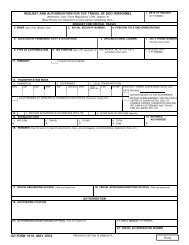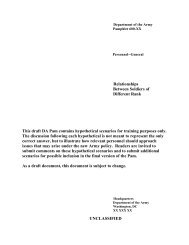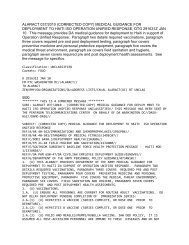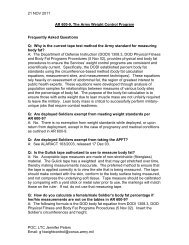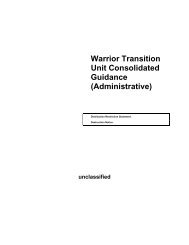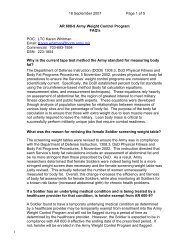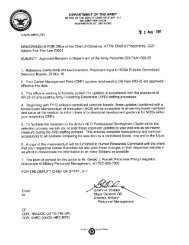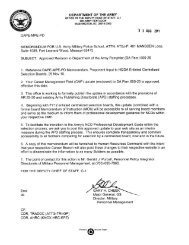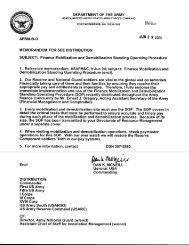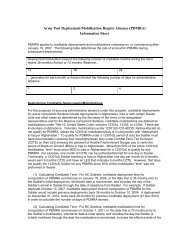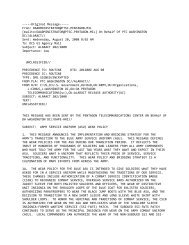Unit Equal Opportunity Training Guide - Deputy Chief of Staff ARMY ...
Unit Equal Opportunity Training Guide - Deputy Chief of Staff ARMY ...
Unit Equal Opportunity Training Guide - Deputy Chief of Staff ARMY ...
Create successful ePaper yourself
Turn your PDF publications into a flip-book with our unique Google optimized e-Paper software.
Chapter 6<br />
Lesson Plan 6—EO Violations Subject to the UCMJ Actions<br />
6–1. OVERVIEW<br />
a. TASK: Identify EO violations which are subject to disciplinary actions under Uniform Code <strong>of</strong> Military Justice<br />
(UCMJ).<br />
b. CONDITIONS: In a classroom environment.<br />
c. STANDARDS: Identify the EO violation or <strong>of</strong>fense and appropriate UCMJ article(s).<br />
d. TARGET AUDIENCE: Leaders and soldiers at all levels.<br />
e. RECOMMENDED INSTRUCTION TIME: 40 minutes.<br />
f. INSTRUCTOR REQUIREMENTS: One instructor per class <strong>of</strong> no more than 25 students.<br />
g. EQUIPMENT NEEDED FOR THE INSTRUCTION: Overhead projector, overhead transparencies (OTs), Figure<br />
6–1, chalkboard and chalk OR butcher paper and magic markers.<br />
h. TOPIC COVERED: EO violations subject to charges under UCMJ.<br />
6–2. INTRODUCTION<br />
a. A significant aspect <strong>of</strong> the Army’s EO program is leader commitment and command support. This implies that<br />
EO, as with any other mission in the Army, must be subject to the full range <strong>of</strong> administrative and disciplinary actions<br />
to correct or punish personnel for inappropriate and illegal behaviors. A soldier’s disobedience and misconduct may<br />
result in consequences unlike any in civilian life. For instance, sexual harassment by a soldier can seriously disrupt a<br />
unit’s mission accomplishment, which could be fatal on the battlefield. Therefore, soldiers and their leaders must have<br />
a clear understanding <strong>of</strong> not only what behaviors are inappropriate, but also understand the consequences for engaging<br />
in or condoning such behavior.<br />
b. When confronted with an EO violation the leader must consider a number <strong>of</strong> factors. Some <strong>of</strong> these include the<br />
severity <strong>of</strong> the behavior, the frequency <strong>of</strong> the act(s), and the circumstances under which the violation occurred. When<br />
considering an appropriate course <strong>of</strong> action to correct the violation the leader may first pursue a number <strong>of</strong> administrative<br />
actions such as on-the-spot correction, formal counseling, training, a memorandum <strong>of</strong> reprimand, or if warranted<br />
administrative separation.<br />
6–3. UCMJ ACTIONS<br />
a. When the EO violation is a more serious breach <strong>of</strong> discipline such as deliberate or repeated <strong>of</strong>fenses or the<br />
violation constitutes a criminal act, punishment under the Code should be considered. Not every EO violation will<br />
warrant UCMJ actions, however soldiers and their leaders must have a clear picture as to which <strong>of</strong>fenses are subject to<br />
the Code.<br />
b. The action taken to address the <strong>of</strong>fense must be appropriate to the specific facts surrounding each incident.<br />
c. The following is a list <strong>of</strong> the more prevalent EO violations which are addressed as <strong>of</strong>fenses and subject to<br />
action(s) under the UCMJ.<br />
Note. Show and discuss OT 6–l, EO VIOLATIONS SUBJECT TO UCMJ ACTIONS.<br />
22 DA PAM 350–20 1 June 1994




